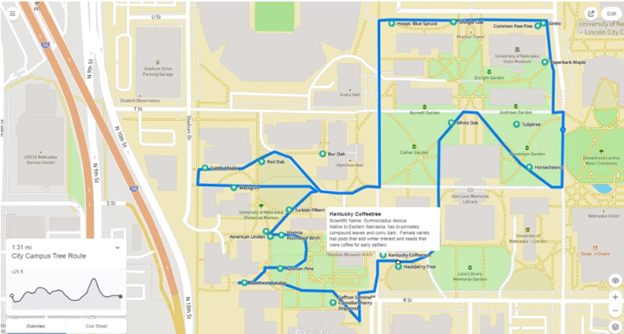
Campus Historic Tree Tour
Everyone has their favorite time of the year on campus, but this time of the year seems extra special with the coolness in the air, trees turning colors and students returning to our beautiful Big 10 campus!
Landscape Services has been working on a Historic Tree Tour for both city campus and east campus and the city tour is now ready to go!
For the city campus historic tree tour, Landscapes Services worked with Assistant Director for Employee Wellness Annalisa Davenport of Campus Recreation and a link is up on the Healthier U website. The walk is called Historic Tree Loop and can be found here: https://healthieru.unl.edu/walking-biking-routes
To view all of the walking tours, create a Footpath account and login. The login will work on both the website and the Footpath app for phones.
The 1.3 mile walk includes 27 trees along the route. Access information about each tree by clicking on the tree. Landscape Services installed an educational sign at each tree that looks similar to the typical tree signs except the top board is a redwood color rather than the typical gray color. Historic Tree Tour is also written on the plaque.
There is information about each tree on the app by clicking on the trees along the walking tour. On city campus, Landscape Services installed signs for each tree are distinguished from the typical sign where the top board is a redwood color rather than typical gray color. Historic Tree Tour was also written on the plaque.
Some examples of trees to see and learn about are:
Shingle Oak (Quercus imbricaria)
Symmetrical rounded crown of an oak tree with atypical unlobed leaves as typical lobed oak leaves. This tree is the largest Shingle Oak in Nebraska and is designated the State Champion Shingle Oak.
Table Rock Maple (Acer saccharum ‘Table Rock’)
A Midwest native tree loved for its exceptional fall color. This cultivar ‘Table Rock’ is from a colony of sugar maple trees found in Table Rock, Nebraska.
American Linden (Tilia americana)
This American Linden is the replacement of the original Schiller tree that was lost in a storm. The Plaque in German says “the great poet and thinker” dedicated by Laurence Fossler, professor of German Language from 1889-1926. Linden trees have nondescript flowers, that are very fragrant in the spring, that become fruits hanging from wing-shaped bracts in the summer.
The next beautiful day plan to learn about the trees on campus.
More details at: https://healthieru.unl.edu/walking-biking-routes